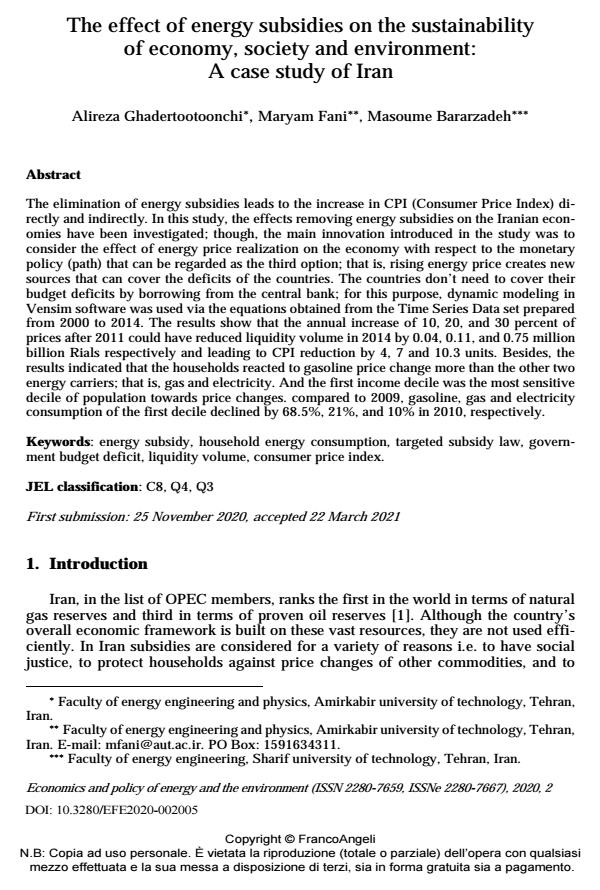The effect of energy subsidies on the sustainability of economy, society and environment: A case study of Iran
Titolo Rivista ECONOMICS AND POLICY OF ENERGY AND THE ENVIRONMENT
Autori/Curatori Alireza Ghadertootoonchi, Maryam Fani, Masoume Bararzadeh
Anno di pubblicazione 2021 Fascicolo 2020/2
Lingua Inglese Numero pagine 37 P. 93-129 Dimensione file 673 KB
DOI 10.3280/EFE2020-002005
Il DOI è il codice a barre della proprietà intellettuale: per saperne di più
clicca qui
Qui sotto puoi vedere in anteprima la prima pagina di questo articolo.
Se questo articolo ti interessa, lo puoi acquistare (e scaricare in formato pdf) seguendo le facili indicazioni per acquistare il download credit. Acquista Download Credits per scaricare questo Articolo in formato PDF

FrancoAngeli è membro della Publishers International Linking Association, Inc (PILA)associazione indipendente e non profit per facilitare (attraverso i servizi tecnologici implementati da CrossRef.org) l’accesso degli studiosi ai contenuti digitali nelle pubblicazioni professionali e scientifiche
The elimination of energy subsidies leads to the increase in CPI (Consumer Price Index) di-rectly and indirectly. In this study, the effects removing energy subsidies on the Iranian econ-omies have been investigated; though, the main innovation introduced in the study was to con-sider the effect of energy price realization on the economy with respect to the monetary policy (path) that can be regarded as the third option; that is, rising energy price creates new sources that can cover the deficits of the countries. The countries don’t need to cover their budget defi-cits by borrowing from the central bank; for this purpose, dynamic modeling in Vensim soft-ware was used via the equations obtained from the Time Series Data set prepared from 2000 to 2014. The results show that the annual increase of 10, 20, and 30 percent of prices after 2011 could have reduced liquidity volume in 2014 by 0.04, 0.11, and 0.75 million billion Rials respectively and leading to CPI reduction by 4, 7 and 10.3 units. Besides, the results indicated that the households reacted to gasoline price change more than the other two energy carriers; that is, gas and electricity. And the first income decile was the most sensitive decile of popula-tion towards price changes. compared to 2009, gasoline, gas and electricity consumption of the first decile declined by 68.5%, 21%, and 10% in 2010, respectively.
Parole chiave:Energy subsidy, household energy consumption, targeted subsidy law, government budget deficit, liquidity volume, consumer price index
Jel codes:C8, Q4, Q3
- Energy System Modeling and Optimization Alireza Ghadertootoonchi, Armaghan Solaimanian, Mehdi Davoudi, Moein Moeini Aghtaie, pp.1 (ISBN:978-3-031-65905-8)
- Planning and Operation of Electric Vehicles in Smart Grids Alireza Ghadertootoonchi, Mehdi Davoudi, Moein Moeini-Aghtaie, Mehdi Rahmani-Andebili, pp.69 (ISBN:978-3-031-35910-1)
Alireza Ghadertootoonchi, Maryam Fani, Masoume Bararzadeh, The effect of energy subsidies on the sustainability of economy, society and environment: A case study of Iran in "ECONOMICS AND POLICY OF ENERGY AND THE ENVIRONMENT" 2/2020, pp 93-129, DOI: 10.3280/EFE2020-002005